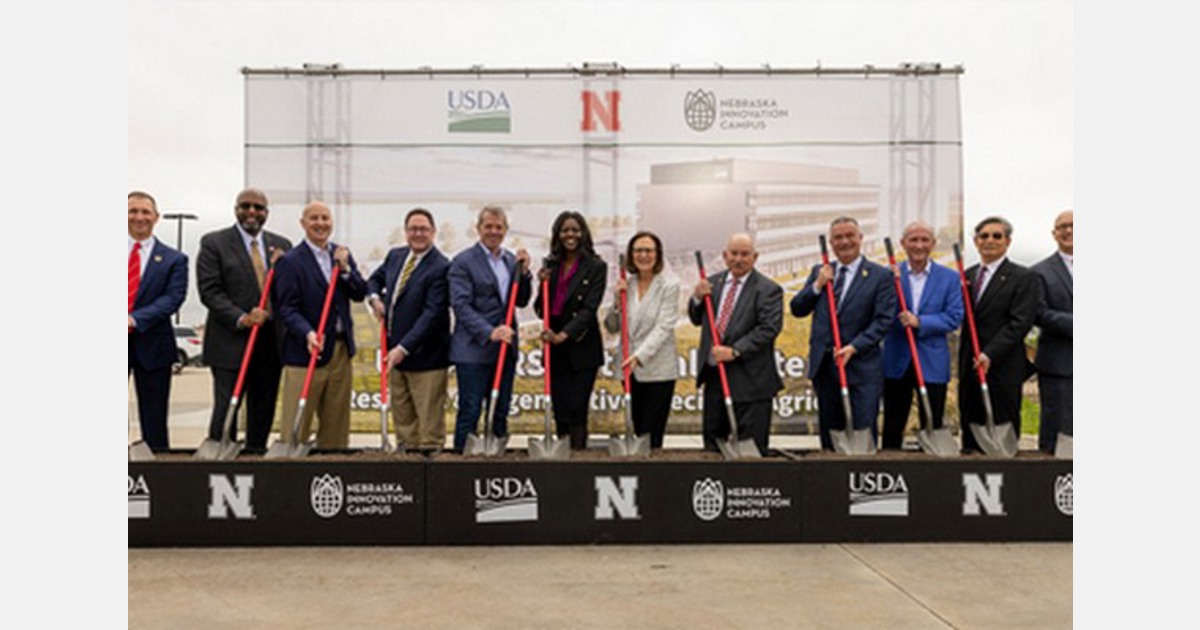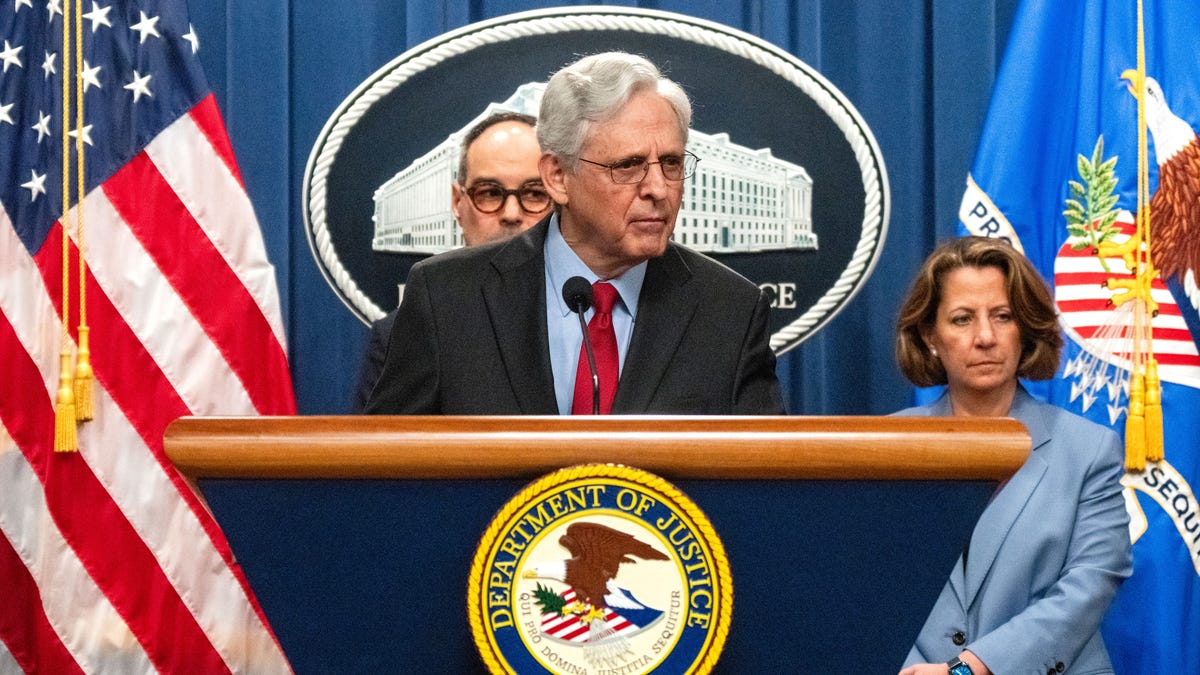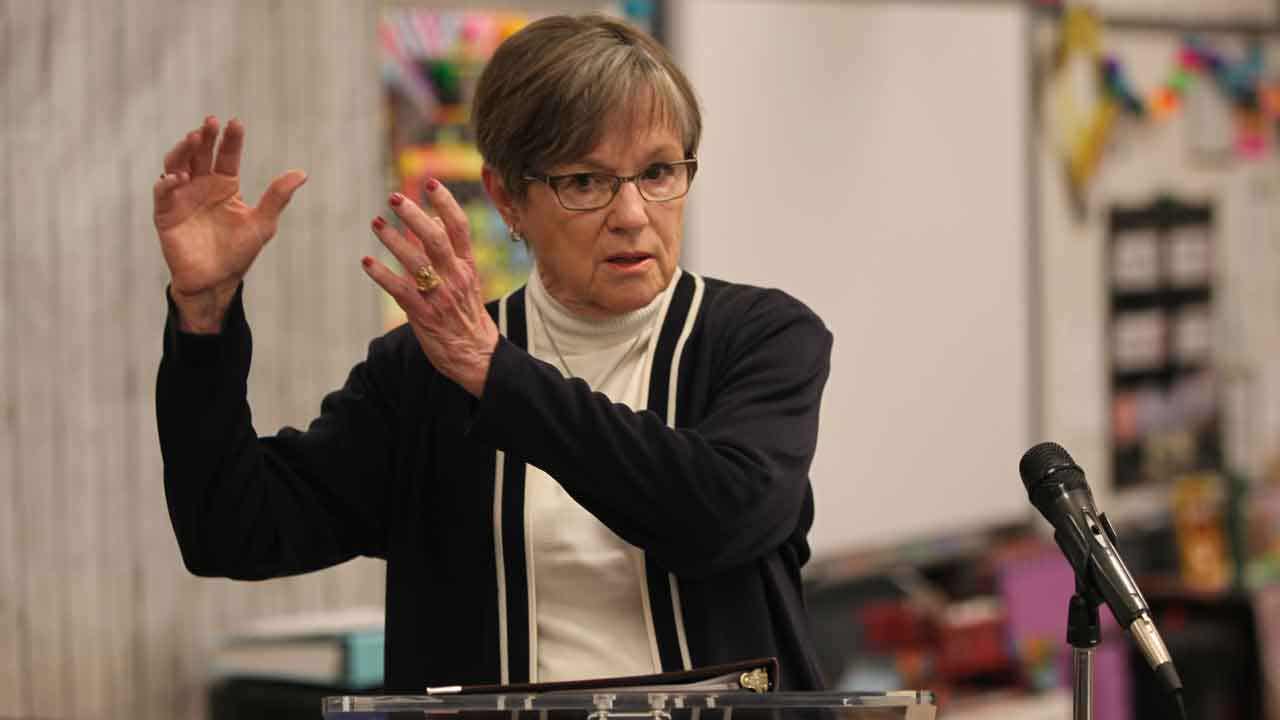Nebraska
US (NE): Nebraska innovation campus break ground for new research center on precision agriculture

The U.S. Department of Agriculture’s (USDA’s) Agricultural Research Service (ARS), the University of Nebraska–Lincoln (UNL), and Nebraska Innovation Campus held a groundbreaking ceremony today to launch the construction of the National Center for Resilient and Regenerative Precision Agriculture. The state-of-the-art research center will be located on Nebraska Innovation Campus in Lincoln, Nebraska. It will primarily focus on the challenges and opportunities in agricultural innovation for the 21st century.
Federal, state and university leaders launched construction of the USDA’s National Center for Resilient and Regenerative Precision Agriculture with a May 6 groundbreaking at Nebraska Innovation Campus. Pictured (from left) is Chris Kabourek, interim president of the University of Nebraska; Rodney D. Bennett, chancellor, University of Nebraska–Lincoln; U.S. Senator Pete Ricketts; U.S. Representative Mike Flood; Nebraska Governor Jim Pillen; Chavonda Jacobs-Young, under secretary for research, education and economics and chief scientist for the USDA; U.S. Senator Deb Fischer; Paul Kenney, University of Nebraska regent; U.S. Representative Don Bacon; Jack Stark, University of Nebraska regent; Simon Liu, USDA-ARS administrator; and Mike Boehem, vice chancellor for UNL’s Institute of Agriculture and Natural Resources. (Photo by Craig Chandler, UNL University Communication and Marketing)
“There is a long history of scientific innovation and collaboration between ARS and UNL, typical of the USDA – Land-grant University partnerships across the country,” said Dr. Chavonda Jacobs-Young, USDA Chief Scientist and Under Secretary for Research, Education, and Economics. “Updated facilities ensure our best and brightest scientists work in the environment and with the tools they need to successfully meet the challenges agriculture faces.”
During this digital era, agricultural production and agricultural landscapes are transforming. Farmers and producers need the latest information technology, tools, and data to make informed and innovative decisions for their unique operations. The Center will focus on key research areas to address these challenges and promote sustainable, resilient, and highly efficient agriculture practices.
“This project is a testament to the long history of innovation, ingenuity, and adaptability of agricultural producers across the United States and right here in Nebraska. It celebrates an incredibly productive 120-year partnership between USDA-ARS and the University of Nebraska–Lincoln, and it exemplifies the passion and dedication of agricultural, state, and federal leaders,” said Mike Boehm, NU Vice President and Harlan Vice Chancellor for UNL’s Institute of Agriculture and Natural Resources. “Nebraska is a special place with incredible people, and the ripples of what we do here often extend around the globe. I believe the work that will take place in this facility will usher in a new era of American agriculture, and I’m thrilled that what happens next in agriculture will happen first in Nebraska.”
Construction will start with state-of-the-art greenhouses that will allow ARS to perform research on wheat, barley, sorghum, forage and bioenergy grasses and other crops. Research on how these plants respond to emerging pests and pathogens under a full-range of environmental conditions will empower scientists to make cutting-edge discoveries with the goal of developing climate-resilient crops for the U.S. agriculture industry.
 Image synthesis (top view) of the fully completed USDA ARS National Center for Resilient & Regenerative Precision Agriculture, including state-of-the-art greenhouses for crop, forage, and bioenergy grasses research. Image courtesy of HDR.
Image synthesis (top view) of the fully completed USDA ARS National Center for Resilient & Regenerative Precision Agriculture, including state-of-the-art greenhouses for crop, forage, and bioenergy grasses research. Image courtesy of HDR.
Once fully completed, the 120,000-square-foot agriculture research complex will function as a central hub for multidisciplinary experts, scientists and engineers who will collaborate with industry and producers to improve water and food security, increase the resilience of agricultural landscapes, and enhance agricultural profitability.
The establishment of the National Center for Resilient and Regenerative Precision Agriculture will further strengthen the long-lasting collaboration over the past century between ARS and UNL. These partnerships are instrumental in advancing research on sustainable bioenergy crops and production systems in an age where agriculture is expected to supply 40 percent of U.S. liquid fuels within the next three decades, in addition to providing food and fiber to the nation’s growing population.
The Wheat, Sorghum and Forage Research Unit and the Agroecosystem Management Research Unit are currently located on UNL’s campus. The scientists working at these units are making significant contributions to crop and livestock production systems by improving productivity, stability of production, sustainability, and profitability.
Source: ars.usda.gov

Nebraska
Sherman: Echoes of a bygone era stir postseason hope for Nebraska baseball

LINCOLN, Neb. — Seven years of postseason magic began a quarter-century ago for Nebraska baseball. It matters more today than at any time since the run came to an end.
I’ll explain.
But first, a story from one of the peak moments of that era: On June 2, 2001, Nebraska hosted Rice in Game 2 of the only super regional ever played at Buck Beltzer Field.
It was, in fact, the final game at the rickety venue, which was quickly razed to make room for football practice space as Dave Van Horn’s baseball program upgraded into its new Haymarket digs. But as the early innings unfolded with a first trip to the College World Series in reach for Nebraska, another day at “The Buck” appeared inevitable.
Rice sent Kenny Baugh to the mound. The hard-throwing right-hander was drafted with the 11th pick of the MLB Draft by the Detroit Tigers three days after his final collegiate appearance that Saturday.
Baugh never played in the big leagues amid the need for shoulder surgery. Part of the reason for his trouble, undeniably, remains buried in Lincoln.
He threw 171 pitches in 8 ⅓ innings against Nebraska. Let that sink in.
None of the first 11 plate appearances for the Huskers ended with a ball in play. Jeff Leise led off the top of the first for Nebraska. It was the visiting team after dispatching the Owls, 7-0, one day prior in the series opener.
Leise struck out. The outstanding player at the Lincoln Regional from the previous week, he walked back toward the third-base dugout. Teammates looked to him for a report on Baugh.
“Good luck,” Leise said he told them, recounting the memory this week. “I didn’t really have much to add other than that. He was mid-90s with his fastball, but it looked harder than that, and he had a power curve.”
Baugh fought his control. Still, several of those 2001 Huskers, in rewatching the game a few years ago, traded texts in wonderment during the replay of the late innings over how Nebraska managed to beat the Owls. The Huskers scored three runs against Baugh in the ninth to take a 6-5 lead and won it in the 10th.
Junior shortstop Will Bolt caught the final out to ignite a dogpile.
The Huskers slayed a dragon. Rice beat Nebraska 16-2 four months earlier in the first game of that season. After another dogpile last Sunday in Omaha when Nebraska won the Big Ten tournament with Bolt at the helm, the Huskers’ resilience and competitive fire echoed a bygone era.
“A lot of memories come flooding back,” Bolt said.
GO DEEPER
Nebraska baseball enters regular-season finale with postseason hopes still on the line
Now, the question is, can they travel a similar path in June?
Van Horn, Bolt’s old coach who has run the show at Arkansas since 2003, masterfully designed his Nebraska program to play with a collective chip on its shoulder.
“People didn’t think much of us when they saw us,” said Leise, a first-team All-American outfielder in 2002 who now provides baseball commentary for the Big Ten Network.
From 1999 to 2005, Nebraska won four Big 12 tournaments. Three times out of the four, the Huskers lost their first games in Oklahoma City, then stormed back to raise a trophy.
These Huskers did the same last week. Instead of Chad Wiles, R.D. Spiehs and Scott Fries who ate innings unexpectedly, it was Will Walsh, Drew Christo and Jackson Brockett. In place of Dan Johnson and Jed Morris who smashed home runs, it was Josh Caron and Gabe Swansen.
“There are certain attributes, certain traits that all (championship teams) have,” Bolt said Sunday. “Toughness is at the top of the list. Talent, you’ve gotta have it. You’ve gotta have the dudes. You’ve gotta have the players.
“The separator is the toughness piece of it, just the unwillingness to waver from a process of showing up and having a job to do.”
In Bolt’s time as a player, Nebraska capitalized on the momentum gained from its second and third Big 12 tourney championships to win regionals. Trips to the CWS followed league tourney titles in 2001 and 2005. Texas beat the Huskers in 2002 to win the Big 12 tournament in Arlington, Texas, before both squads advanced to the CWS.
I had a front-row seat for the rise of Nebraska baseball, reporting on those teams daily during the postseason for the Omaha World-Herald. What struck me was not the heroics on the diamond that put the Huskers over the top in do-or-die games.
It was their composure and togetherness. They were more of a force off the field than on it. I’ve seen more teams like them in decades of watching the CWS up close. Many hoisted trophies in Omaha.
“You can tell this team is close,” Leise said. “They go to bat for each other. When things get tough, they fight through adversity. We played that way. We practiced that way. There was a level of excellence that everybody strived for.”
Ohio State flattened Nebraska 15-2 in the opening game for both teams at this year’s Big Ten tournament. Just as the Huskers responded after several difficult defeats in April and May, they won last week behind ace pitcher Brett Sears. He beat Purdue, and then Nebraska went to work in ending the stays of Ohio State, Indiana and Penn State.
“That confidence and that experience,” Bolt said, “that postseason feel, the butterflies, all of that they’re taking with them this week.”
Championship numbers. 📊🏆 pic.twitter.com/nIS5CWp0cM
— Nebraska Baseball (@HuskerBaseball) May 29, 2024
The Huskers head to the Stillwater Regional as the No. 2 seed of four teams, set to face Florida on Friday at 2 p.m.
Sears will be on the mound, ready to slay a dragon.
LSU beat the Gators last year in the decisive third game of the CWS championship series. This year, Florida still hits home runs like a national title contender. But it’s 28-27 and snuck into the 64-team field.
“We’ll play anybody in the country and it’s not going to change our approach,” Christo said. “We’re going to show up and be the same team every day.”
That these Huskers last week showed a resemblance to the best teams in school history — with a coach who connects one era to the other — offers hope of a memorable June on the horizon.
(Photo of Caleb Clark: Courtesy of Nebraska Athletics)
Nebraska
Nebraska state senator says schools could be using critical mapping this year

LINCOLN, Neb. (WOWT) – Critical Response Group was founded by military special operations veterans.
It provides aerial and gridded overlay mapping for school districts across the country to use during emergency situations.
“We basically took how we map and communicate overseas during counter-terrorism raids, and we took that technique and we started to adopt it and adapt it for schools,” chief operating officer Alex Carney said.
He said during the Uvalde and Sandy Hook shootings, the floorplans were either inaccessible or inaccurate, leading to what he called poor decisions by law enforcement.
On top of providing these maps to school districts, they also work with agencies to familiarize personnel with using them.
The Nebraska Legislature passed a bill this spring opening the doors for school districts to buy mapping services such as these. It also provides state grants to help districts pay for them.
“The school board has to then decide if this is what they want, and then put it up for bid,” said State Sen. Ben Hansen of Blair. “Then they can make a decision on who they best see fit.”
Hansen, who proposed the original bill, told 6 News he doesn’t know the specific date on when funds will be ready for distribution, but some school districts could begin using these services as soon as this year.
Hansen added that with the funding the state did allocate for this, some school districts can get the ball rolling, and lawmakers can see what districts think about it. Then, they may bring an amendment next year to raise the funding.
Copyright 2024 WOWT. All rights reserved.
Nebraska
University of Buffalo names U. Nebraska CIO as next tech chief | EdScoop

The University of Buffalo in New York on Tuesday announced that Heath Tuttle, associate vice president for information technology for the University of Nebraska system, was appointed as its next chief information officer following a nationwide search launched five months ago.
Tuttle will depart his role with the University of Nebraska, where he also serves as CIO at the University of Nebraska-Lincoln campus, to begin his new position in New York on August 1, according to a press release.
“Together, we will drive innovation and elevate our technology infrastructure, ensuring it is accessible and inclusive for all,” Tuttle said in the release. “By leveraging strategic partnerships and cutting-edge technologies, we will advance the university’s mission and foster a dynamic, transformational technology ecosystem that empowers every member of our community.”
While at the University of Nebraska system, Tuttle was responsible for a digital transformation initiative that improved teaching and learning technologies, processes and support. He also played a role in developing the Lincoln campus’ use of emerging technologies, such as artificial intelligence.
“A strategic leader with extensive experience in higher education IT, Heath has a demonstrated record of aligning diverse technology objectives into a cohesive vision focused on digital transformation, operational excellence, collaboration and accessibility,” University of Buffalo President Satish Tripathi said in the release. “I am confident that he will provide exemplary leadership that builds upon our robust technology environment, elevates our IT practices and advances our university priorities and goals.”
Tuttle succeeds J. Brice Bible, who departed the University of Buffalo in February to serve as CIO at the University of South Carolina. During the search for Bible’s replacement, E. Bruce Pitman, a professor at the university’s Department of Materials Design and Innovation, served as interim CIO at the University of Buffalo, the release said.
In his new role, Tuttle will be tasked with advancing the university’s research and education while also delivering a “well-aligned, innovative and robust technology environment,” the release said.
-

 Culture1 week ago
Culture1 week agoFrom Dairy Daddies to Trash Pandas: How branding creates fans for lower-league baseball teams
-

 World1 week ago
World1 week agoPanic in Bishkek: Why were Pakistani students attacked in Kyrgyzstan?
-

 News1 week ago
News1 week agoRed Lobster files for bankruptcy after missteps including all-you-can-eat shrimp
-

 News1 week ago
News1 week agoThe states where abortion is on the ballot in November : Consider This from NPR
-

 Movie Reviews1 week ago
Movie Reviews1 week agoMai Movie Review: Emotionally powerful lead performances in this sensitive and heart-breaking romantic film
-

 Politics1 week ago
Politics1 week agoMichael Cohen swore he had nothing derogatory on Trump, his ex-lawyer says – another lie – as testimony ends
-

 Politics1 week ago
Politics1 week agoAnti-Israel agitators interrupt Blinken Senate testimony, hauled out by Capitol police
-

 News1 week ago
News1 week agoCity of Kyle falls short of ‘Kyle’ world record















